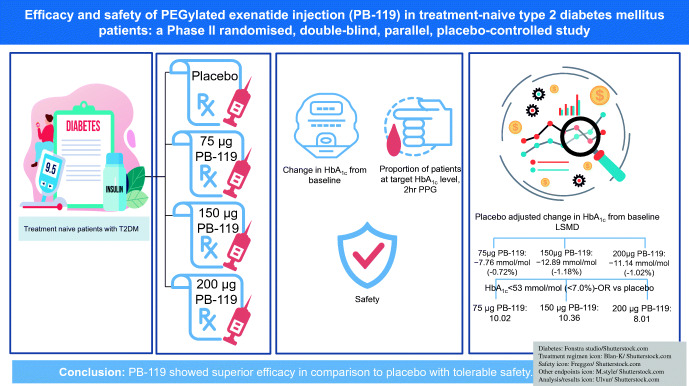- Record: found
- Abstract: found
- Article: found
Efficacy and safety of PEGylated exenatide injection (PB-119) in treatment-naive type 2 diabetes mellitus patients: a Phase II randomised, double-blind, parallel, placebo-controlled study

Read this article at
Abstract
Aims/hypothesis
Glucagon-like peptide 1 receptor agonists (GLP-1 RA) such as exenatide are used as monotherapy and add-on therapy for maintaining glycaemic control in patients with type 2 diabetes mellitus. The current study investigated the safety and efficacy of once-weekly PB-119, a PEGylated exenatide injection, in treatment-naive patients with type 2 diabetes.
Methods
In this Phase II, randomised, placebo-controlled, double-blind study, we randomly assigned treatment-naive Chinese patients with type 2 diabetes in a 1:1:1:1 ratio to receive subcutaneous placebo or one of three subcutaneous doses of PB-119 (75, 150, and 200 μg) for 12 weeks. The primary endpoint was the change in HbA 1c from baseline to week 12, and other endpoints were fasting plasma glucose, 2 h postprandial glucose (PPG), and proportion of patients with HbA 1c < 53 mmol/mol (<7.0%) and ≤48 mmol/mol (≤6.5%) at 2, 4, 8 and 12 weeks of treatment. Safety was assessed in all patients who received at least one dose of study drug.
Results
We randomly assigned 251 patients to one of the four treatment groups ( n = 62 in placebo and 63 each in PB-119 75 μg, 150 μg and 200 μg groups). At the end of 12 weeks, mean differences in HbA 1c in the treatment groups were −7.76 mmol/mol (95% CI −9.23, −4.63, p < 0.001) (−0.72%, 95% CI −1.01, −0.43), −12.89 mmol/mol (95% CI −16.05, −9.72, p < 0.001) (−1.18%, 95% CI −1.47, −0.89) and −11.14 mmol/mol (95% CI −14.19, −7.97, p <0 .001) (−1.02%, 95% CI −1.30, −0.73) in the 75 μg, 150 μg and 200 μg PB-119 groups, respectively, compared with that in the placebo group after adjusting for baseline HbA 1c. Similar results were also observed for other efficacy endpoints across different time points. There was no incidence of treatment-emergent serious adverse event, severe hypoglycaemia or death.
Conclusions/interpretation
All tested PB-119 doses had superior efficacy compared with placebo and were safe and well tolerated over 12 weeks in treatment-naive Chinese patients with type 2 diabetes.
Related collections
Most cited references29
- Record: found
- Abstract: found
- Article: not found
Biology of incretins: GLP-1 and GIP.
- Record: found
- Abstract: found
- Article: not found
9. Pharmacologic Approaches to Glycemic Treatment: <i>Standards of Medical Care in Diabetes—2019</i>

- Record: found
- Abstract: found
- Article: found
